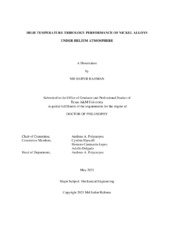| dc.contributor.advisor | Polycarpou, Andreas | |
| dc.creator | Rahman, Md Saifur | |
| dc.date.accessioned | 2021-05-21T15:20:26Z | |
| dc.date.available | 2021-05-21T15:20:26Z | |
| dc.date.created | 2021-05 | |
| dc.date.issued | 2021-04-30 | |
| dc.date.submitted | May 2021 | |
| dc.identifier.uri | https://hdl.handle.net/1969.1/193326 | |
| dc.description.abstract | Currently the health and well-being of the global society are affected by energy source efficiency, reliability and enviromental impact. Nuclear power is one of the realiable energy resources with low greenhouse gas emissions per unit energy generated. Findings from the current research directly result in more reliable and efficient nuclear power plants. The objective of this research is to systematically evaluate the tribological response of 800HT and 617 alloys at relevant reactor operating temperatures (700-950 °C) and in the presence of helium (He) coolant. This research aims to address the need for a clear and inclusive understanding of the tribological performance of Nickel (Ni) based alloys in high temperature (HT) gas cooled reactors HTGR/VHTR operational environment that will clarify the necessity of further enhancement in HT durability and environmental compatibility of tribological components operating in HTGR-He coolant. The fundamental knowledge in high temperature tribology, especially in controlled gas atmosphere is limited, mainly due to complexity of experimental tests and analytical/numerical methods. The present work is pushing the boundaries of in-situ multiscale (nano/micro/macro) characterization of tribological materials in air/non-air ambient conditions at very high temperatures through novel experimental setups (e.g., very high temperature tribometer and very high temperature nano-indenter, under controlled Helium conditions). Also, comprehensive surface layer composition studies using advanced electron microscopy and other material characterization techniques, provide insght into prevention and failure mechanisms. Using a custom-built high temperature tribometer, helium cooled reactor environment was simulated at room and 950 oC temperatures. Microscopy and chemical analyses are carried out to explain the tribological performance of the alloys. At elevated temperatures, both alloys show higher friction in helium, compared to air environment. Both alloys exhibit high wear resistance in all experimental conditions, except at high temperature helium environment. The formation of glazed and mechanically mixed layers of oxides were found to be important causes for the lower friction and wear in high temperature air atmosphere. The in-depth chemical analysis of the oxide layer using techniques like EDS, XRD, RAMAN and SIMS were performed to link the tribochemical aspects to the evolution of mechanical properties under contact. This work provides new knowledge in the form of scientific papers, technical reports, and presentations that benefits a wide range of communities, and individuals. Most importantly this work is showcasing the important tribological issues encountered in suture state-of-the-art nuclear reactors. | en |
| dc.format.mimetype | application/pdf | |
| dc.language.iso | en | |
| dc.subject | High temperature, Tribology, Nuclear reactor, Inconel 617, Alloy 800HT, Nanoindentation, Nanoscratch, Helium tribology | en |
| dc.title | HIGH TEMPERATURE TRIBOLOGY PERFORMANCE of NICKEL ALLOYS under HELIUM ATMOSPHERE | en |
| dc.type | Thesis | en |
| thesis.degree.department | Mechanical Engineering | en |
| thesis.degree.discipline | Mechanical Engineering | en |
| thesis.degree.grantor | Texas A&M University | en |
| thesis.degree.name | Doctor of Philosophy | en |
| thesis.degree.level | Doctoral | en |
| dc.contributor.committeeMember | Hipwell, Cynthia | |
| dc.contributor.committeeMember | Delgado, Adolfo | |
| dc.contributor.committeeMember | Castaneda, Homero | |
| dc.type.material | text | en |
| dc.date.updated | 2021-05-21T15:20:26Z | |
| local.etdauthor.orcid | 0000-0003-3616-1028 | |


